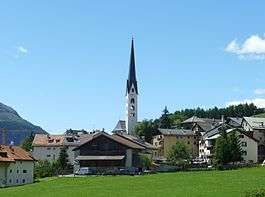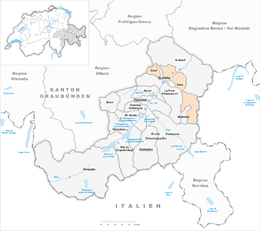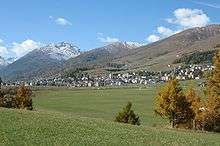Zuoz
| Zuoz | ||
|---|---|---|
 | ||
| ||
 Zuoz | ||
|
Location of Zuoz  | ||
| Coordinates: 46°36′N 9°58′E / 46.600°N 9.967°ECoordinates: 46°36′N 9°58′E / 46.600°N 9.967°E | ||
| Country | Switzerland | |
| Canton | Graubünden | |
| District | Maloja | |
| Area[1] | ||
| • Total | 65.79 km2 (25.40 sq mi) | |
| Elevation | 1,716 m (5,630 ft) | |
| Population (Dec 2015[2]) | ||
| • Total | 1,250 | |
| • Density | 19/km2 (49/sq mi) | |
| Postal code | 7524 | |
| SFOS number | 3791 | |
| Surrounded by | Bergün/Bravuogn, La Punt-Chamues-ch, Livigno (IT-SO), Madulain, Pontresina, S-chanf | |
| Website |
www SFSO statistics | |
Zuoz (![]() [tsuə̯ts] ) is a municipality in the district of Maloja in the Swiss canton of Graubünden.
[tsuə̯ts] ) is a municipality in the district of Maloja in the Swiss canton of Graubünden.
History
Zuoz is first mentioned about 840 as Zuzes.[3] Historically, Zuoz was the political center of the upper Engadin. It was the seat of the local bishop. But, it has long ago been supplanted by other Engadin villages such as St. Moritz and Samedan.
In 1137-39 the village was acquired from the count von Gamertingen by the Bishop of Chur. In 1244 Bishop Volkart appointed Andreas Planta from Zuoz to be the chancellor of the Oberengadin. The Planta family remained in power until 1798. In 1367, Zuoz joined the League of God's House under the leadership of the Amtmann Thomas Planta.
The continuing arguments between Zuoz and Samedan led, in 1438, to the division of the court into two parts, the courts of Sur and Suot Funtauna Merla. In 1492, the village bought the Bishop's property and rights to tax in Zuoz. Then, in 1526 the Bishop lost the right to high justice with the Ilanzer articles. In the Swabian War the inhabitants ignited their fields to force the enemy to retreat. Over the course of the 15th Century, several villages became independent of Zuoz. S-chanf left in 1518, La Punt-Chamues-ch in 1528 and Madulain in 1534. In 1554, Zuoz joined the Protestant Reformation and converted.
In 1512, the Three Leagues conquered the Valtellina valley. The improved trade routes and money that this valley brought, led to a golden age in the Engadin valley. During this time in Zuoz; a Latin school was established, the first written Romansh language was developed and choir singing spread in both religious and everyday theater. In addition Zuozer students visited foreign schools.
After the Bündner Wirren (or Confusion of the Leagues) from 1618 to 1639, many residents of the village emigrated seeking jobs in other regions. The loss of the Valtellina valley led to further emigrations and loss of political power. Following the end of the Ancien Régime and creation of the Canton of Raetia in the French controlled Helvetic Republic in 1798, all of Zuoz's privileges and political power vanished. It became a simple farming village.Zuoz still practices ancient traditions which date back to long before the Catholic Christianity. These include San Gian and Chalandamarz [3]
Geography

Zuoz has an area, as of 2006, of 65.6 km2 (25.3 sq mi). Of this area, 49.5% is used for agricultural purposes, while 9.2% is forested. Of the rest of the land, 1.1% is settled (buildings or roads) and the remainder (40.2%) is non-productive (rivers, glaciers or mountains).[4]
The municipality is located in the Oberengadin sub-district of the Maloja district. The village center is located on the slope of Munt Albanas and is surrounded by new developments.
Demographics
Zuoz has a population (as of 31 December 2015) of 1,250.[2] As of 2008, 37.0% of the population was made up of foreign nationals.[5] Over the last 10 years the population has decreased at a rate of -5.8%.[4]
As of 2000, the gender distribution of the population was 51.7% male and 48.3% female.[6] The age distribution, as of 2000, in Zuoz is; 127 children or 9.4% of the population are between 0 and 9 years old. 88 teenagers or 6.5% are 10 to 14, and 241 teenagers or 17.8% are 15 to 19. Of the adult population, 154 people or 11.4% of the population are between 20 and 29 years old. 164 people or 12.1% are 30 to 39, 202 people or 14.9% are 40 to 49, and 152 people or 11.2% are 50 to 59. The senior population distribution is 101 people or 7.5% of the population are between 60 and 69 years old, 87 people or 6.4% are 70 to 79, there are 34 people or 2.5% who are 80 to 89, there are 2 people or 0.1% who are 90 to 99, and 1 person who is 100 or more.[5]
In the 2007 federal election the most popular party was the SVP which received 42.3% of the vote. The next three most popular parties were the FDP (25.6%), the SP (25.2%) and the CVP (5%).[4]
In Zuoz about 72.5% of the population (between age 25-64) have completed either non-mandatory upper secondary education or additional higher education (either university or a Fachhochschule).[4]
Zuoz has an unemployment rate of 1.37%. As of 2005, there were 40 people employed in the primary economic sector and about 10 businesses involved in this sector. 116 people are employed in the secondary sector and there are 15 businesses in this sector. 462 people are employed in the tertiary sector, with 59 businesses in this sector.[4]
From the 2000 census, 476 or 35.2% are Roman Catholic, while 667 or 49.3% belonged to the Swiss Reformed Church. Of the rest of the population, there are 36 individuals (or about 2.66% of the population) who belong to the Orthodox Church, and there are 7 individuals (or about 0.52% of the population) who belong to another Christian church. There are 14 (or about 1.03% of the population) who are Islamic. There are 6 individuals (or about 0.44% of the population) who belong to another church (not listed on the census), 107 (or about 7.91% of the population) belong to no church, are agnostic or atheist, and 40 individuals (or about 2.96% of the population) did not answer the question.[5]
The historical population is given in the following table:[3][6]
| year | population |
|---|---|
| 1781 | 423 |
| 1850 | 378 |
| 1900 | 425 |
| 1930 | 969 |
| 1941 | 693 |
| 1950 | 779 |
| 1960 | 1,001 |
| 1970 | 1,165 |
| 1980 | 1,186 |
| 1990 | 1,199 |
| 2000 | 1,353 |
Languages
Most of the population (as of 2000) speaks German (53.2%), with Romansh being second most common (25.8%) and Italian being third ( 9.8%).[4] Until the 19th Century, the entire population spoke the Upper-Engadin Romansh dialect of Puter. Due to increasing trade with the outside world, Romansh usage began to decline. In 1880 about 85% spoke Romansh as a first language, while in 1910 and again in 1941 it was only 56%.
| Languages in Zuoz | ||||||
| Languages | Census 1980 | Census 1990 | Census 2000 | |||
| Number | Percent | Number | Percent | Number | Percent | |
| German | 457 | 38.53% | 547 | 45.62% | 720 | 53.22% |
| Romansh | 461 | 38.87% | 407 | 33.94% | 349 | 25.79% |
| Italian | 183 | 15.43% | 144 | 12.01% | 133 | 9.83% |
| Population | 1186 | 100% | 1199 | 100% | 1353 | 100% |
Education
The public primary school system is Scoula Zuoz (German: Gemeindeschule Zuoz).[7] Its two sites are Scoula da La Plaiv and Scoula Primara Zuoz.[8] Scuola Primaria Zuoz has primary levels, and da La Plaiv has secondary and realschule classes.[7]
Lyceum Alpinum Zuoz, a private school, is in Zuoz.
Sights
Zuoz is an example of a traditional Engadin village. It has many cobblestoned streets, an elegant town center and numerous beautiful old buildings. In the winter it offers an increasingly large family ski resort with large chair and T-bar lift, as well as a cross-country ski center. In the summer it has a golf course and numerous hiking trails.
Zuoz is home to the Lyceum Alpinum Zuoz, a prestigious preparatory school which has a high proportion of foreign nationals.
It is also home to the famous "Posthotel Engadina", a hotel with 2 restaurants, a cafe, a pool and newly refurbished rooms. As well as the Hotel Castell, a magnificent 5-star hotel with several restaurants, a sauna and an outdoor mountain pool, as well as many works of art and fantastic scenery.
Zuoz also still retains many of its ancient traditions which it inherited from the Roman empire, including San Gian and Chalandamarz
Heritage sites of national significance
The Chaplutta S. Bastiaun and Chasa Pult are listed as Swiss heritage sites of national significance.[9]
References
- ↑ Arealstatistik Standard - Gemeindedaten nach 4 Hauptbereichen
- 1 2 Swiss Federal Statistical Office - STAT-TAB, online database – Ständige und nichtständige Wohnbevölkerung nach institutionellen Gliederungen, Geburtsort und Staatsangehörigkeit (German) accessed 30 August 2016
- 1 2 3 Zuoz in German, French and Italian in the online Historical Dictionary of Switzerland.
- 1 2 3 4 5 6 Swiss Federal Statistical Office accessed 21-Oct-2009
- 1 2 3 Graubunden Population Statistics Archived August 27, 2009, at the Wayback Machine. (German) accessed 21 September 2009
- 1 2 Graubunden in Numbers Archived September 24, 2009, at the Wayback Machine. (German) accessed 21 September 2009
- 1 2 "Gemeindeschule Zuoz"/"Scoula Zuoz." Zuoz. Retrieved on November 15, 2016.
- ↑ Home. Scoula Zuoz. Retrieved on November 15, 2016.
- ↑ Swiss inventory of cultural property of national and regional significance Archived May 1, 2009, at the Wayback Machine. 21.11.2008 version, (German) accessed 21-Oct-2009
| Wikimedia Commons has media related to Zuoz. |
External links
- Zuoz in Romansh, German, French and Italian in the online Historical Dictionary of Switzerland.
